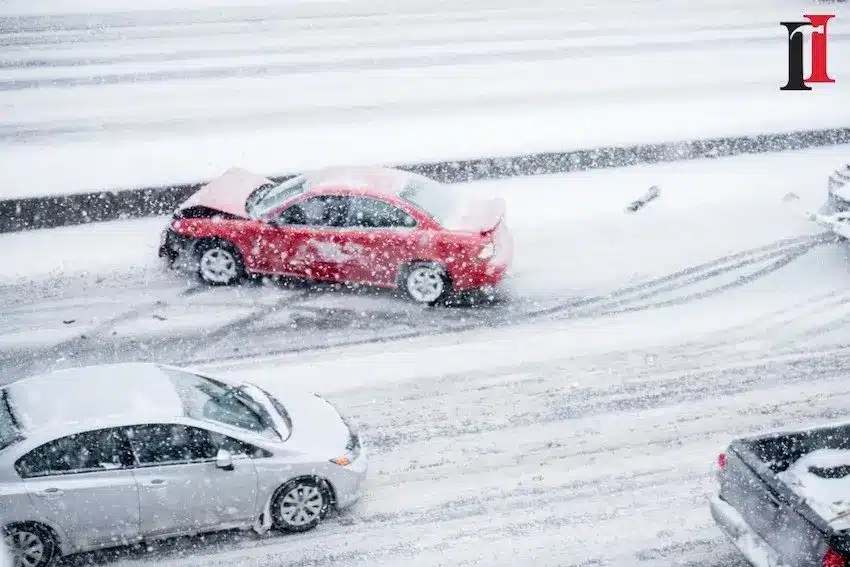Winter Driving Tips for Snow and Icy Roads
Last updated Tuesday, November 5th, 2024

Driving in snow comes with obvious hazards and takes both preparation and know-how to do safely, along with good judgment to avoid when necessary. According to the National Highway and Traffic Safety Administration, 17% of all vehicle crashes occur during winter weather conditions. The highest percentage of drivers (41%) speeding in fatal crashes occurred on icy or frosty roads.2 Building your accident prevention strategies and snow emergency car kit are essential to winter driving safety.

Tips for Driving in the Snow
When driving in fog or snow, keeping a few winter driving safety tips in the forefront of your mind can make a huge difference for both safety and convenience.
Stay Visible on the Roads
Drivers who use headlights are safer, but by how much? According to a National Highway and Traffic Safety accident resourcesstudy, the use of daytime running lights decreased accidents between trucks/vans and two passenger vehicles by 5.7 percent.3 If you’re visible, you’re less likely to get in an accident.
Prepare Your Vehicle for Winter Driving
Include these essentials as you prepare for winter driving that involves wet, snowy or icy conditions.
- Vehicle Maintenance: Get your car tuned up before the cold weather arrives. Make sure to get your windshield wipers checked along with coolant levels.
- Charged Car Battery: Winter takes a toll on batteries. Include a battery check with your next oil change or car servicing. As temperatures drop below zero, batteries can freeze when not fully charged. Consider thermal wrappings for your battery and when possible, run the engine each day for 10-15 minutes to warm the battery.
- All-Weather Snow Tires: An all-wheel drive or SUV is helpful, but a recent survey published by Consumer Reports noted the safety value of snow and winter tires, with boosts in driver confidence knowing that snow tires provide stronger tire traction. Make sure your tires are always filled to the suggested PSI, and double-check the tire threading.
- Carry Snow Chains: In some areas chains will be required, and in areas where they are not, they may become essential in deeper terrain. Choose your parking locations carefully, avoiding deeper snow packs that make traction difficult, even with snow tires.
Are Front Wheel Drive Cars Good In Snow?
While they don’t provide the same winter driving safety benefits of 4-wheel drive vehicles, front-wheel drive (FWD) cars are designed so that the bulk of the vehicle’s weight rests above the two front wheels. Snow tires add an additional layer of safety when driving in the snow.
Create a Snow Emergency Car Kit
The Kentucky Transportation Cabinet includes the following essentials in its snow kit for cars. We’ve added their essentials to what the National Safety Council recommends cars carry at all times.
- Blankets
- Candles and matches
- Cat litter for traction
- Cell phone and Car Charger
- Compass
- Drinking Water
- Duct Tape
- Fire Extinguisher
- First-aid Kit
- Flashlight and Batteries
- Ice Scraper
- Inflated spare tire, wheel wrench and tripod jack
- Jumper cables
- Non Perishable snacks
- Rain poncho
- Reflective triangles
- Reflective vest
- Shovel
- Snow Brush
- Tool Kit
- Warm Clothing
- Windshield Washer Fluid
Car Stuck in the Snow? Here’s How to Get Out
If you find your vehicle stuck in snow, with tires endlessly rotating, you’re not alone. Snow does not need to be deep for your tire traction to fail. Here’s how to get yourself (and your car) out of the situation:

- Clear a Path for your Tires – Consider this “building your runway” – Consumer Reports notes that when a shovel isn’t available, consider turning to a “hubcap, a piece of wood, the base of the car jack, or the spare-tire cover.”
- Using the Rocking Method – If your car moves even a little, you might be able to build enough momentum by rolling forward and backward, eventually gaining traction to move out of the snow.
- Provide Traction for Your Wheels – Some ideas for traction that have provided successes for cars stuck in the snow include branches and wood pieces, cat litter, cardboard, snow chains (laid on the ground) and sand. You’ll want those wheels to run right over the traction point and give you a snow-free revolution to set you free. Several manufacturers also produce commercial traction aids for cars and trucks.
Driving On Ice Tips
Driving on ice very often involves a car sliding on ice, leading to collisions with injuries. Here are some of the winter driving tips that apply directly to icy conditions.
Increase Your Following Distance
The National Highway Traffic Safety Administration (NHTSA) notes that it takes longer than 4 seconds to come to a complete stop while driving 55mph on a dry road, and even longer to stop in wintery conditions. Since that translates into needing 600 feet or more to completely stop on ice, it’s highly recommended to increase your following time by one second while driving on icy or slippery roads.
Slow Down On Wet and Icy Roads
This one might sound obvious, but that doesn’t stop motorists from speeding. The amount you slow down depends on the road conditions. The Federal Motor Carrier Safety Administration (FMCSA) advises drivers to reduce speeds by 1/3 while driving on wet roads, and for snowy and icy roads, to cut your speed in half (or more).
Avoid Using Cruise Control on Ice
Cruise control is best used for long stretches of flat roads with dry conditions. The Automobile Club (AAA) notes the following:
“On wet roads, cruise control set at too fast a speed could cause the vehicle to hydroplane when it encounters standing water. On very low-traction surfaces such as ice and snow, cruise control operation can result in a skid or spin.”
Avoid using cruise control on slippery road conditions like rain, snow and ice.
Use the Engine Braking Method for Reducing Speed
Reducing speed is certainly the top-recommended driving practice to avoid sliding on ice. Gentle tapping of the brakes is advised over sudden sharp braking which often spells disaster. The National Motorists Association recommends downshifting on slick downhill grades. Sometimes known as the engine braking method, this slows down your vehicle without any use of the brakes, which may be prone to overheating in these conditions.
Safe Driving On Black Ice
“Black ice” refers to ice on the road that is completely transparent. It’s particularly dangerous because drivers are looking at what appears to be regular pavement, but are instead greeted with perilously slick surfaces. Black ice typically forms at night or in early morning and in areas without much sun exposure like bridges, overpasses, tunnels, tree-lined routes. It’s known to even creep up in driveways and sidewalk areas. Always remain aware of the possibility of black ice dangers.
If you run into black ice, just remember, the brakes are not your friend. The US Forest Service recommends the following for black ice driving encounters:
- Remain as calm as possible, do not overreact
- Do as little as possible – allow the car to pass over the ice
- Do not use the brakes
- Keep your steering wheel straight
- If you begin sliding, very gently adjust the steering wheel. Overcorrecting may lead to spinning out of control.
- Downshift into a lower gear if possible to allow the car to slow down without braking
Car Safety Features Don’t Replace Safe Driving
A 2019 State Farm study revealed that Americans who drive vehicles equipped with advanced safety technology are more likely to take risks while driving, such as texting and using video chat. Vehicle safety features are only effective as long as drivers practice engaging, safe driving behaviors. Every driver must guard against distracted driving, especially when road conditions include ice or snow.
What To Do When Injured in a Bad Weather Accident
Even if you did everything right, there’s no guarantee the other drivers sharing the road will follow all of the rules. If you’ve been in a car accident involving snow or ice, we’ll review your case for free and help you determine the best path forward for justice and compensation. Call Isaacs & Isaacs today at 800-333-9999.
Download the Winter Car Checklist
Isaacs & Isaacs, Primary Office
1601 Business Center Ct
Louisville, KY 40299
3. The Effectiveness of Daytime Running Lights For Passenger Vehicles]↩













